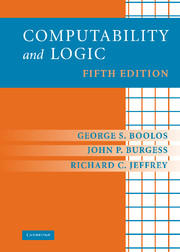Book contents
- Frontmatter
- Contents
- Preface to the Fifth Edition
- COMPUTABILITY THEORY
- BASIC METALOGIC
- 9 A Précis of First-Order Logic: Syntax
- 10 A Précis of First-Order Logic: Semantics
- 11 The Undecidability of First-Order Logic
- 12 Models
- 13 The Existence of Models
- 14 Proofs and Completeness
- 15 Arithmetization
- 16 Representability of Recursive Functions
- 17 Indefinability, Undecidability, Incompleteness
- 18 The Unprovability of Consistency
- FURTHER TOPICS
- Annotated Bibliography
- Index
14 - Proofs and Completeness
Published online by Cambridge University Press: 05 June 2012
- Frontmatter
- Contents
- Preface to the Fifth Edition
- COMPUTABILITY THEORY
- BASIC METALOGIC
- 9 A Précis of First-Order Logic: Syntax
- 10 A Précis of First-Order Logic: Semantics
- 11 The Undecidability of First-Order Logic
- 12 Models
- 13 The Existence of Models
- 14 Proofs and Completeness
- 15 Arithmetization
- 16 Representability of Recursive Functions
- 17 Indefinability, Undecidability, Incompleteness
- 18 The Unprovability of Consistency
- FURTHER TOPICS
- Annotated Bibliography
- Index
Summary
Introductory textbooks in logic devote much space to developing one or another kind of proof procedure, enabling one to recognize that a sentence D is implied by a set of sentences г, with different textbooks favoring different procedures. In this chapter we introduce the kind of proof procedure, called a Gentzen system or sequent calculus, that is used in more advanced work, where in contrast to introductory textbooks the emphasis is on general theoretical results about the existence of proofs, rather than practice in constructing specific proofs. The details of any particular procedure, ours included, are less important than some features shared by all procedures, notably the features that whenever there is a proof of D from г, D is a consequence of г, and conversely, whenever D is a consequence of г, there is a proof of D from г. These features are called soundness and completeness, respectively. (Another feature is that definite, explicit rules can be given for determining in any given case whether a purported proof or deduction really is one or not; but we defer detailed consideration of this feature to the next chapter.) Section 14.1 introduces our version or variant of sequent calculus. Section 14.2 presents proofs of soundness and completeness. The former is easy; the latter is not so easy, but all the hard work for it has been done in the previous chapter. […]
- Type
- Chapter
- Information
- Computability and Logic , pp. 166 - 186Publisher: Cambridge University PressPrint publication year: 2007



